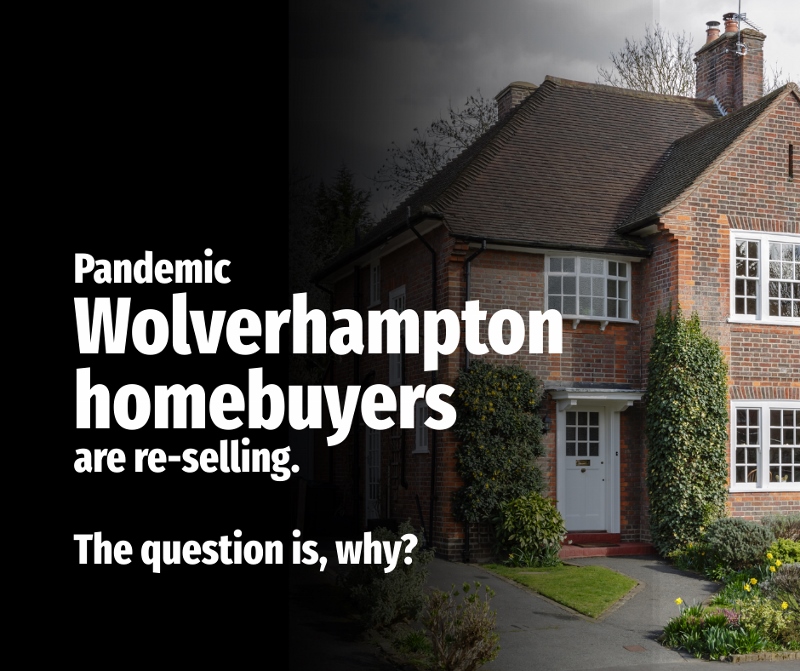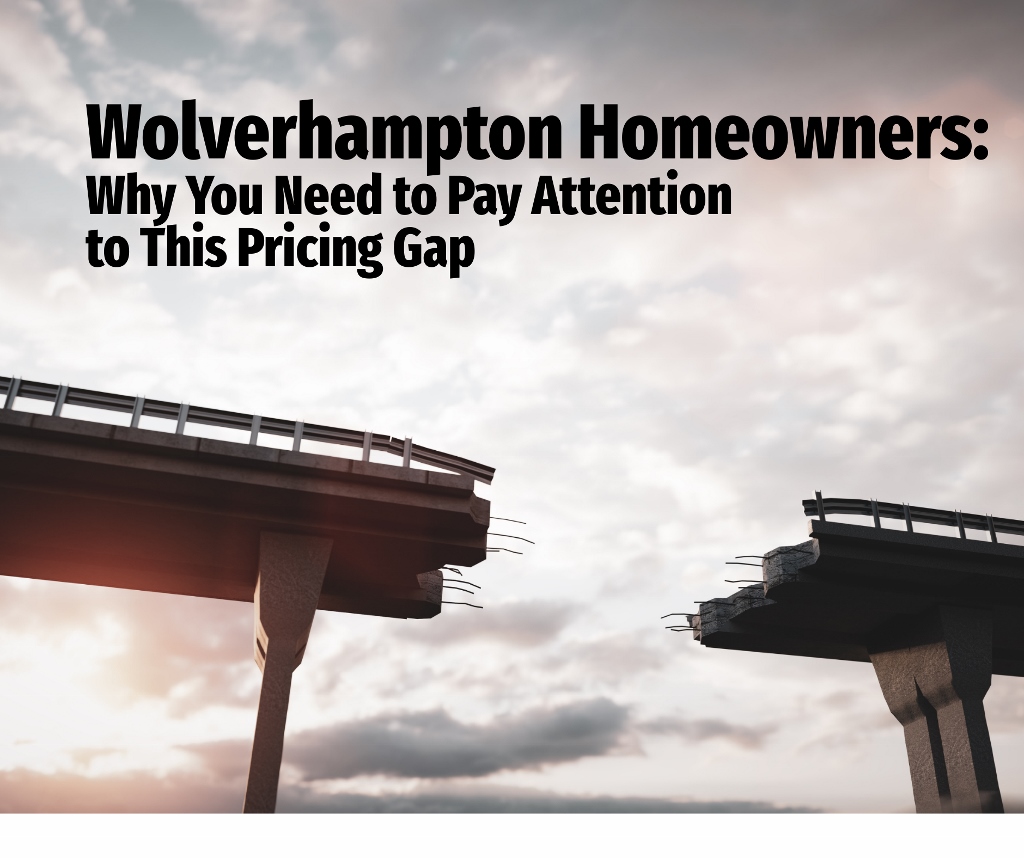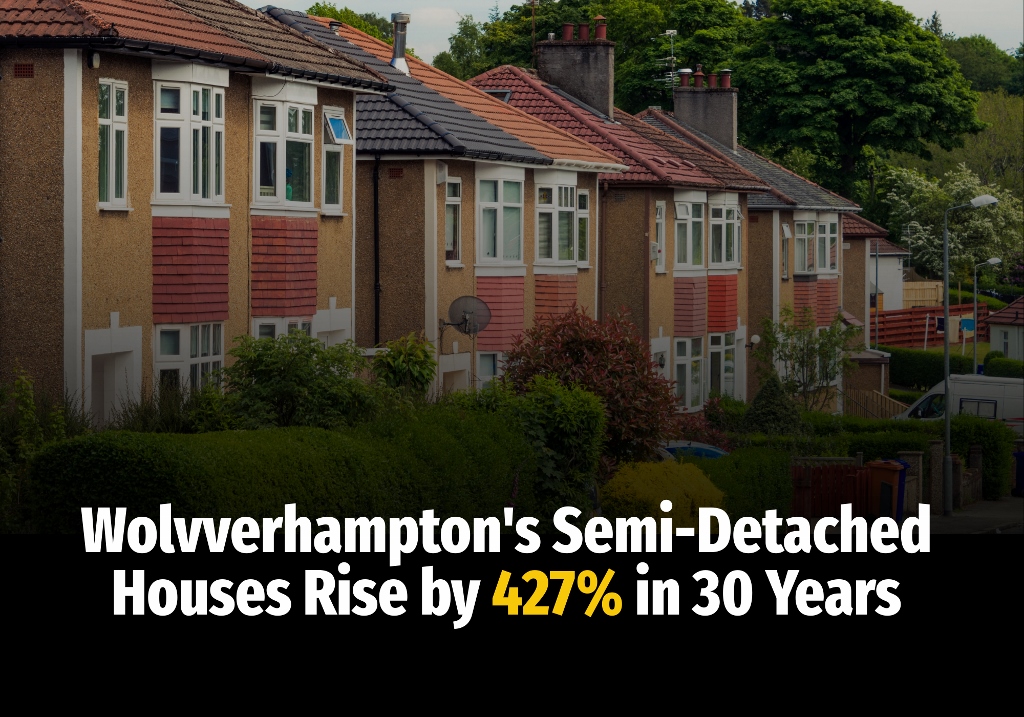Blog
- Details
Are you considering moving home in Wolverhampton during the next 6 to 12 months?
You may be a Wolverhampton landlord deciding whether to grow your portfolio or sell off a few properties. Or you're a Wolverhampton first-time buyer wondering if now is the right time to move.
Understanding whether the current property market favours buyers or sellers is key to making the right call. If you follow our regular Wolverhampton property updates, you'll know one of the most reliable ways to assess the market is by looking at the percentage of homes marked as "Sold STC" or "Under Offer" compared to the total number of properties on the market.
Let's show that in practice. In this example, if there are 400 properties on the market in a location, and say 300 properties are for sale, fully available to buy, and the remaining 100 are under offer or sold. 100 as a percentage of 400 gives us a sales percentage of 25%. It is this percentage that strongly indicates the local property market temperature and who holds the upper hand, i.e., buyers or sellers (or somewhere between).
This percentage figure acts as a barometer for market conditions and can be analysed using this table:
- Extreme Buyers' Market (0%-20%)
- Buyers' Market (21%-29%)
- Balanced Market (30%-40%)
- Sellers' Market (41%-49%)
- Hot Sellers' Market (50%-59%)
- Extreme Sellers' Market (60%+)
How Does Wolverhampton Compare?
Examining historical data from The Advisory's website, which has tracked this metric for years, reveals some key trends for each month in 2025. (For this exercise, Wolverhampton is WV1/2/3/4/6/10/11).
- January 2025. 49%.This placed Wolverhampton at the upper end of a sellers’ market, giving sellers a modest advantage to start the year.
- February 2025. 47%.A slight decline kept conditions within the sellers’ market, though with a little more room for buyers to negotiate.
- March 2025. 46%.A further easing maintained Wolverhampton in the sellers’ market, reflecting stability rather than major change.
- April 2025. 48%.The figure edged back up, reinforcing the sellers’ market position and showing steady demand.
- May 2025. 47%.A small dip kept the market in sellers’ territory, signalling consistency.
- June 2025. 47%.The figure remained unchanged, highlighting stability within the sellers’ market.
- July 2025. 50%.A rise moved Wolverhampton into a hot sellers’ market, giving sellers stronger leverage.
- August 2025. 52%.Another increase consolidated conditions in the hot sellers’ market, showing that demand remained resilient.
Overall trend. From January to August 2025, Wolverhampton’s figures ranged between 46% and 52%. The city has consistently been in a sellers’ market, with more recent months pushing into the hot sellers’ category. Overall, conditions have leaned firmly in favour of sellers, supported by steady buyer demand.
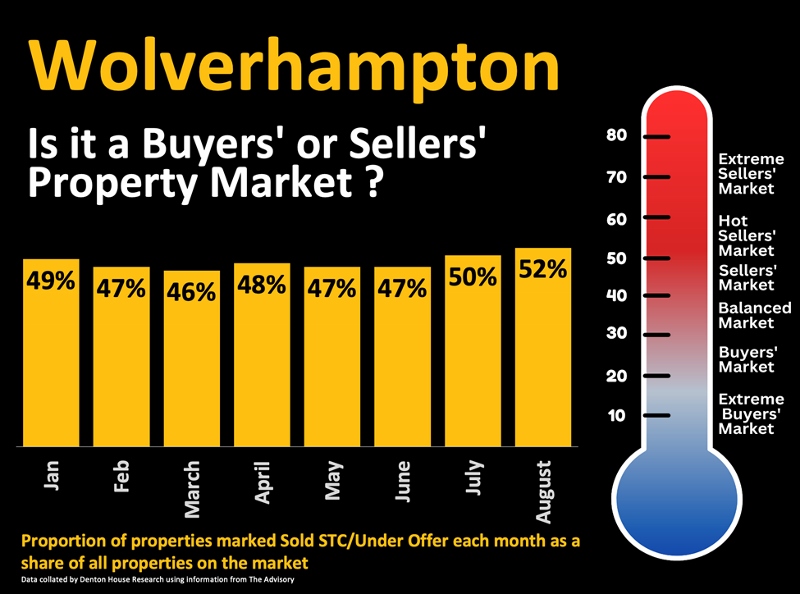
These percentage figures are an average of the Wolverhampton postcodes (as noted above).
For interest, if we break down the August 2025 figure by individual Wolverhampton postcodes, it actually tells an even more interesting story…
- WV1 – 55%
- WV2 – 48%
- WV3 – 51%
- WV4 – 50%
- WV6 – 43%
- WV10 – 51%
- WV11 – 65%
Look at the difference between the postcodes!
So, what does a 52% "Sold STC to total stock" ratio mean for Wolverhampton right now?
It places the local market at the lower end of a hot sellers’ market. Sellers have the advantage and buyers need to bring their best game.
For Wolverhampton Sellers
We are firmly in a market where patience, presentation, and accurate pricing matter more than ever. Buyers now have a choice, a lot of choice. Simply listing your property and hoping for the best will not cut it.
The homes that sell are those that hit the market with the right price from day one, have high-quality photography, clear floor plans, strong virtual/video tours, and marketing that stretches both online and offline.
Overpricing is the fastest way to stall a sale. Properties that linger usually face price reductions, lose momentum, and invite lower offers. In some cases, that even leads to failed sales before the exchange.
Getting it right at launch is critical.
The good news is the recent interest rate cut provides a welcome tailwind as first-time buyers are seeing lower monthly payments, encouraging more of them into the market and strengthening chains. Also, home movers can access better fixed-rate deals, helping them upsize, remortgage, and release more homes onto the market to buy. Finally, buy-to-let investors in Wolverhampton's stronger-yielding areas may see the sums stacking up again.
Buyer sentiment is shifting. Rate cuts show the Bank of England wants growth and stability, which converts hesitant "wait and see" buyers into active "let's book a viewing" buyers.
This is not a one-off. The cut follows earlier reductions since late 2024. This means mortgage rates are more palatable, with some two-year fixes, at the time of writing, being below 3.75% on a 60% loan-to-value (LTV) basis, and an impressive 3.86% on a 5-year fixed (60% LTV). For first-time buyers with a 5% deposit, a 3-year fixed 4.78% rate on a 95% LTV mortgage looks pretty fair.
For Wolverhampton Buyers
The market is calmer than the frenzy of 2021 and 2022. There is time to think, compare, and in some cases negotiate. That does not mean you can wait indefinitely or fire in lowball offers. The best homes are still competitive, but opportunities exist if you are open-minded and look beyond the most sought-after postcodes. Have your mortgage agreement in principle ready before making an offer. It sets you apart and gives sellers confidence. Also, consider widening your search area, as value is often found just beyond the obvious hotspots.
Final Thoughts on the Wolverhampton Property Market
With inflation rising slightly (meaning interest rates won’t be coming down too much in the near future) and the Government finances looking a little squeaky, while the UK’s (and Wolverhampton's) property market is enjoying a steadier footing, realistic pricing is the ultimate and most important thing in marketing a property. Remember last month, only 50.9% of homes that left estate agents' books ended up being sold and the homeowner moving (the rest being withdrawn from the market unsold). Of course, you might not get what you would've got a few years ago in the crazy years of 2020 and 2021, but the price you'll have to pay on the next one won't be as much either.
If you are considering a move within the next six months or would like to explore your options, let's talk. And even if you are not moving, I would love to hear your thoughts on where you see the Wolverhampton market heading.
- Details
A step-by-step guide for Wolverhampton homeowners
You want more space. The kitchen bleeds into homework time. The spare room became an office, then a dumping ground. The obvious answer used to be to extend.
Yet over the last few years, the sums have changed. This is an article for Wolverhampton homeowners who are weighing up an extension against moving. It gives you the maths, the practical snags, and a simple checklist so you can make a confident decision for your family.
The simple maths of extending your Wolverhampton home in 2025
Think of an extension as two numbers fighting each other.
- What it adds to value.
- Roughly, added value equals new floor area multiplied by what buyers pay per square foot in your street and your price band.
- Added value = new area × local £ per sq.ft.
- What it really costs.
- Not just the bricks and labour. Add professional fees, approvals, VAT, a sensible contingency, and the life disruption that no one prices in at the start.
- All-in cost per sq. ft = build cost per sq. ft × VAT × fees × contingency.
So, let's look at the average value achieved …
2,384 houses have sold in the last 12 months in Wolverhampton.
The average £ per sq. ft has been £259 per sq. ft.
(Wolverhampton WV1-4/6/10/11).
Next, we must look at the costs.
Use this as a starting point for most single-storey projects in 2025.
- Build cost per sq. ft - the budget end is around £167 per sq. ft, all the way up to £325 per sq. ft for top of the range.
- VAT is 20% on extensions, so that must be added to the above figure.
- Professional fees and approvals are on top and are between 10 to 15% of the build cost.
- Contingency (money if things go wrong), at least 10%, ideally 12.5%.
So, a mid-level Wolverhampton property, the all-in cost per sq. ft looks like this.
- Mid-level range build at £243 per sq. ft.
- With VAT, that increases to £291 per sq. ft.
- Add 15% for professional fees, now it's £334 per sq. ft.
- And finally, adding 10% for contingencies, that leaves about £367 per sq. ft, all-in.
That number matters. It is the breakeven point for your home extension.
However, two-storey projects can offer better value because foundations and roofs are shared. A rough rule that many use is that extra storey costs are about 30% to 50% cheaper per square foot for the first floor.
Let me look at some worked examples.
A single-storey 200 sq. ft worked example
- New area, 200 sq. ft.
- Cost per sq. ft £367.
- Total project outlay for a single-storey Wolverhampton dwelling = £73,400.
- Total value added (200 sq. ft at £259 per sq. ft) = £51,800.
A double-storey 400 sq. ft worked example
- New area, 400 sq. ft.
- Cost per sq.ft (the ground floor - 200 sq. ft at £367 and first floor 200 sq. ft at £256).
- Total project outlay about £124,600.
- Total value added (400 sq. ft at £259 per sq. ft) = £103,600.
You can see the gap.
Wolverhampton is not one market. The old part, the interwar semis, new build estates, village edges, each has a different £ per sq. ft, so let’s look at this map …
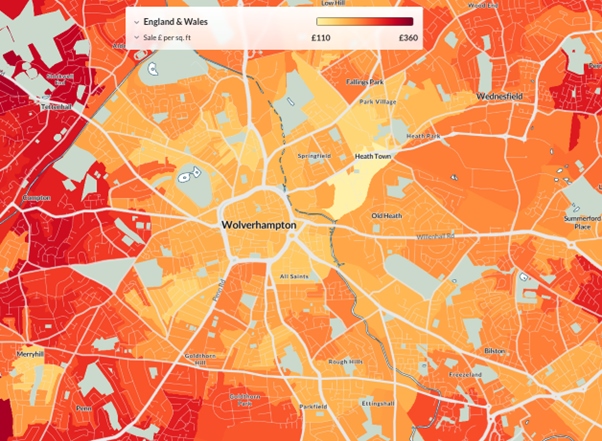
Yet, it is not all about the pure pound notes when deciding to extend or not. Let us expand on those ..
- Details
In the summer of 2020, Wolverhampton's property market, like the rest of the UK, roared back to life after weeks of pandemic lockdown. It was a strange moment in history. The pause in the British housing market had created a bottleneck of pent-up demand, and when the doors reopened, homes that might have taken months to sell were suddenly attracting multiple offers in a matter of days.
Average asking prices jumped sharply, fueled by a combination of limited supply, government incentives such as the temporary stamp duty cut, and a rush of buyers rethinking their living arrangements. For many, the pandemic was a nudge to make changes they had been considering for years, and others, it was the trigger for an impulsive leap.
Buyers who had been cooped up in flats suddenly had the freedom (and in many cases, the budget) to look for more space. A house with a garden, perhaps a home office, or even a semi-rural location outside the main town, became the dream. For some, it was a complete relocation from busier urban areas to the countryside.
In those frenzied months of 2020 and 2021, the competition was fierce. Both our estate agent colleagues and with other agencies in the city, recall Wolverhampton homes being listed on a Friday and sold by Monday morning, often well above the asking price. Many buyers were willing to compromise on location, condition, and amenities to secure a property.
Now, certain newspapers and commentators are saying there is a flood of homeowners putting their homes on the market for sale who bought in that initial post-pandemic rush. Before we look at what is happening in the Wolverhampton property market, let us explore why this could be happening.
Why are these homes coming back to the market?
Several factors are at play:
- Changing work patterns
In 2020, many people were told they could work from home indefinitely. That made a longer commute seem irrelevant. But since 2022, more employers have been encouraging or mandating a return to the office, even if it is just for part of the week. For some, that means facing the reality of a long drive or a costly rail season ticket again.
- Mortgage costs
Back in mid-2020, five-year fixed mortgage rates (75% loan-to-value) were just above 2%. Now they are hovering around 4% to 4.2% (even with the recent interest rate cut). For households that stretched themselves financially during the pandemic, this has created real pressure as fixed deals expired. In some cases, the only way to manage rising costs is to downsize or move to a more affordable area.
- Lifestyle reassessment
During the pandemic, the appeal of more space was overwhelming. But bigger gardens mean more upkeep. Longer distances from shops, schools, or family can be inconvenient. Some people have found that the trade-offs they accepted in 2020/1, for example, being miles from the nearest railway station or amenities, are no longer worth it.
- Second-home pressure
While not as common in Wolverhampton itself, those who bought second homes in coastal or rural spots during the pandemic are now facing higher running costs and new council tax surcharges. That has pushed some to sell, adding more properties to the broader regional market.
- Pure buyer's remorse
In the heat of the pandemic property boom, decisions were often made quickly and with limited viewing opportunities. Some owners are now simply realising that the house they bought doesn't suit them as well as they had hoped.
So, let us look at the cold hard facts in the British property market
In the years before Covid (2016–2020), 29.4% of homes that sold had been owned for five years or less. Over the last 12 months, that figure has risen to 34.1%. A proportional rise of 16%. So, a rise, not a flood.
If we extend the time frame to seven years or less, the difference narrows to 44.6% pre-COVID compared with 48.4% in the past year.
The real change lies in when people are moving. Pre-Covid, more sales happened in years five and six of ownership. Today, there is a clear uplift in people moving earlier, particularly in years three and four.
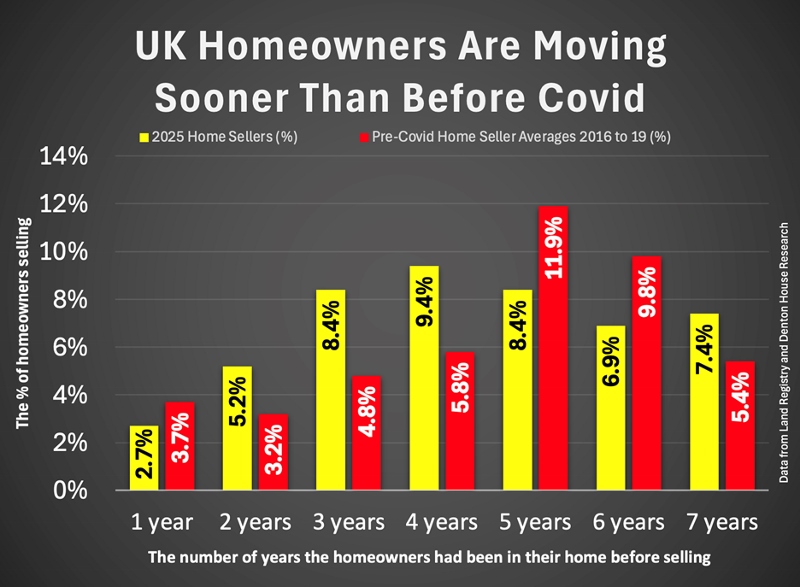
Wolverhampton Property Market Stats
Looking at the stats locally, let us see what is happening in Wolverhampton (WV1/2/3/4/6/10/11).
Of the 1,910 homes for sale or sold stc …
163 of those were purchased between the middle of May 2020 and the end of December 2021. Meaning 8.5% of Wolverhampton homes bought in the 18 months after lockdown are back on the market (either available or sale agreed SSTC).
They are split down:
- Detached - 41, which represents 9.1% of the detached Wolverhampton homes for sale.
- Semi - 69, which represents 9.0% of the semi-detached Wolverhampton homes for sale.
- Terraced/town house – 24, which represents 7.3% of the Wolverhampton terraced/town homes for sale.
- Bungalow - 12, which represents 8.9% of the Wolverhampton bungalows for sale.
- Flat/apartment - 17, which represents 7.3% of the Wolverhampton flats/apartments for sale.
The impact on house prices in Wolverhampton
Across the country, the total number of properties for sale is at its highest since 2013, and Wolverhampton is no exception. Compared with the height of the pandemic, stock levels locally have risen sharply. While more choice is good news for buyers, it creates a more challenging environment for Wolverhampton home sellers, especially those who overpaid in the heat of the market.
The property price growth of the pandemic years has slowed down. Between mid-2020 and September 2022, average prices in Wolverhampton rose significantly, as the rush for space played out. But in the past two and a half years, house growth has been almost flat.
Homes that are priced correctly still sell well, but the days of "name your price" are gone. Overpricing is particularly risky in a market with more competition. In the last three months, 35.7% of the 768,500 homes for sale had to reduce their prices.
Advice for Wolverhampton house sellers in 2025
If you bought during the pandemic and are now considering selling, the key is to be realistic:
- Price for today, not for 2021. Use evidence from recent completions in your area, not what your neighbour sold for three years ago.
- Presentation matters. In a more cautious market, buyers are drawn to properties that feel turnkey and well-maintained.
- Be ready to negotiate. Buyers know there is more choice and will push for value.
- Choose an agent who knows the data. The best local estate agents can show you exactly how your home compares to others in terms of days on market, percentage of asking price achieved, and past selling history.
For Wolverhampton buyers, it's an opportunity.
For those looking to buy in Wolverhampton, the current conditions are far better than they were five years ago. There's more choice, less competition, and in many cases, room to negotiate.
The "five-year itch" means there's a steady supply of relatively modernised homes from the 2020–21 buying spree coming onto the market. Many are in good condition, as owners have only been in them for a short period.
Looking ahead
It's unlikely we'll see a return to the intense post-pandemic conditions in the Wolverhampton market any time soon. The dynamic between supply and demand currently favours buyers, and while falling mortgage rates could shift the balance slightly, most analysts expect this to remain the case into 2026.
For Wolverhampton homeowners, the lesson from the last five years is that property decisions made in haste can lead to changes of heart sooner than expected. Whether you are selling or buying, the most successful moves now are based on solid research, realistic expectations, and a clear-eyed view of what matters in your next home.
- Details
If you’re a homeowner in Wolverhampton thinking about selling, brace yourself for a bit of uncomfortable truth.
There is a growing gap in our city between what Wolverhampton home sellers want and what buyers are actually willing to pay. And the evidence for this is laid out, month after month, in cold, hard numbers.
Since the summer of 2020, we’ve been tracking two key numbers: the average asking price of homes coming to market in Wolverhampton, and the average sale price of homes that exchanged and completed. The results are striking and eye-opening.
In 2025 so far, the average asking price of the homes coming onto the market in Wolverhampton has been £285,100. But the average price of a Wolverhampton home that’s actually sold and completed is £260,300. That’s a 9.5% difference.
And no, this isn’t about a property crash or Wolverhampton sellers taking a 9% or more hit on their asking prices. This is about what sells versus what sits on the market.
It’s Not That Wolverhampton House Prices Are Falling. It’s That High-Priced Wolverhampton Homes Don’t Sell as Well
Let’s be very clear. This 9.5% gap doesn’t mean house prices have dropped by 9.5%. It simply shows that Wolverhampton homes at the higher end of the market are much less likely to sell. They get listed, they linger, and they often withdraw unsold. Meanwhile, lower-priced Wolverhampton homes tend to fly off the shelf.
It’s a classic case of saleability versus ambition.
In 2020, the gap between average asking and average sale price in Wolverhampton was also 9.5% (£228,900 asking vs £209,100 selling).
By 2021, that fell to just 4.5%. Rose to 10.4% in 2022, 11.4% in 2023, 13.2% in 2024, and now we’re nudging 10% in 2025.
(Wolverhampton is WV1-4/6/10/11).
- Details
Once mocked as middle-of-the-road suburbia, Wolverhampton's semi-detached homes have quietly become one of the strongest performers in the property market.
Looking at Wolverhampton house price data has given the humble semi the last laugh, with an astounding average price increase of 427% over the past three decades. This impressive rise in house prices has made the humble semis a wise investment and underscores their enduring appeal in the broader British housing market.
This article will examine the appeal of semi-detached houses in Wolverhampton and explore why they will continue to charm homebuyers into the future.
A Historical Evaluation of the British Semi-Detached House
Semi-detached houses have been a staple of British housing for well over 150 years, with their origins tracing back to the Victorian and Edwardian periods. Back then, they were often referred to as ‘villas’, a term that reflected their aspirational appeal and middle-class respectability. These homes were designed to offer more space, light, and privacy than terraces, while still being more affordable than fully detached properties, a perfect compromise for the growing suburban population of the time.
While much of Europe leans towards apartment living in dense urban environments, the British have long favoured the comfort and independence that comes with a semi. They offer a rare balance: neighbours nearby, but not too close. A front and back garden, room to grow, and a sense of personal space … all without the price tag of going fully detached. It’s this blend of practicality and privacy that continues to make the semi-detached home one of the UK’s most popular and enduring property types.
Wolverhampton Semi-Detached Houses Hold Their Own Against Other Property Types
Wolverhampton's semi-detached houses have performed well against other property types in terms of house price growth. Over the past 30 years, Wolverhampton semis have seen an average price increase of 427%, compared to …
- Wolverhampton detached homes – 382%
- Wolverhampton terraced homes – 428%
- Wolverhampton apartments - 303%
The average price paid for a semi-detached home in Wolverhampton in the last 12 months has been £228,654.
The Enduring Appeal of Semi-Detached Homes
Semi-detached houses have long held a special place in the British housing market. They deliver many of the lifestyle advantages of detached homes but without the full price tag, making them an ideal stepping stone for families and first-time buyers alike.
A key element that is often overlooked is the role of gardens in enhancing their appeal. A modest front garden softens the boundary between private and public space, offering not just kerb appeal but also a sense of privacy and distance from the road.
Meanwhile, the rear garden acts as a personal retreat. Whether it’s a place for children to play, adults to unwind, or space to entertain guests in summer, it’s a feature that sets semi-detached homes apart from many terraces. Practicality also plays a role, allowing for side access that’s ideal for bin storage, bikes, or even a shed. These are small details that make everyday life easier.
Internally, many semi-detached homes are surprisingly generous. Larger reception rooms give space to dine, relax, and entertain. While the bedrooms might not rival those of detached properties, they strike a balance between comfort and functionality. It's this combination of character, space, and affordability that explains why so many British families have grown up in a semi-detached house and why many continue to want one.
Why Wolverhampton’s Semi-Detached Homes Remain in High Demand
Wolverhampton is home to a rich variety of semi-detached properties, ranging from charming period homes packed with character to sleek, modern builds designed for today’s lifestyles. This mix of old and new creates broad appeal among buyers seeking both style and practicality.
Since 1995, there have been 23,269 semi-detached homes
sold in Wolverhampton.
That's 44.45% of all property sales in the city over the past 30 years.
As demand for semi-detached homes continues to grow, they are proving themselves to be not only a practical choice but also a wise long-term investment.





